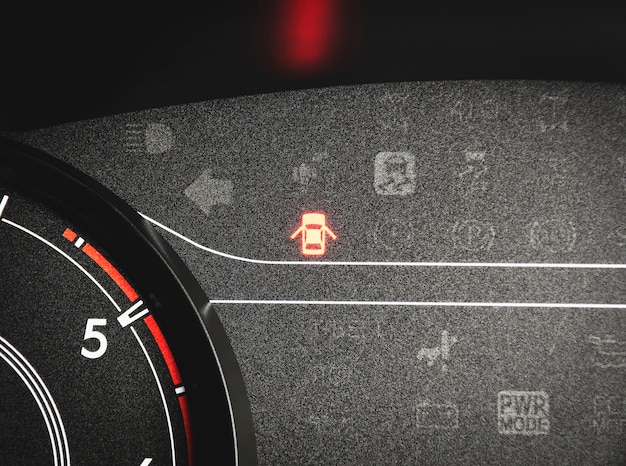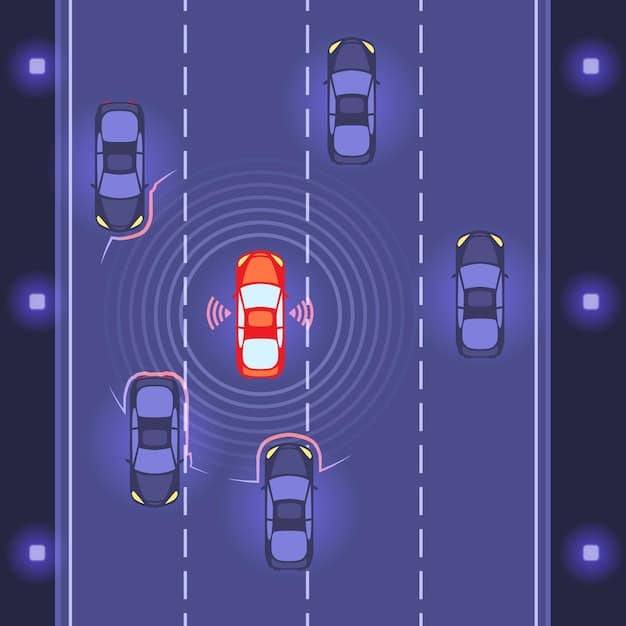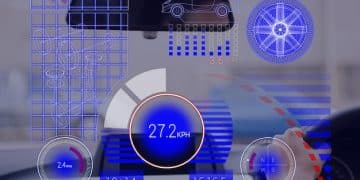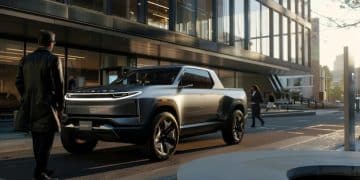Latest Automotive Safety Tech Trends and Their Impact on US Roads

The latest trends in automotive safety technology, such as advanced driver-assistance systems (ADAS), automatic emergency braking (AEB), and enhanced cybersecurity measures, are significantly reducing accidents and improving road safety across the US.
The automotive industry is undergoing a safety revolution, driven by innovative technologies designed to protect drivers, passengers, and pedestrians. What Are the Latest Trends in Automotive Safety Technology and Their Impact on US Roads? This article explores these advancements and their growing influence on road safety in the United States.
Advanced Driver-Assistance Systems (ADAS)
Advanced Driver-Assistance Systems, or ADAS, represent a significant leap forward in automotive safety. These systems utilize a network of sensors, cameras, and radar to monitor the vehicle’s surroundings and assist the driver in various ways, aiming to prevent accidents and mitigate the severity of collisions.
From lane keeping assist to adaptive cruise control, ADAS functionalities enhance situational awareness and actively intervene when necessary. Let’s delve into some of the key components of these systems.
Lane Keeping Assist (LKA)
Lane Keeping Assist (LKA) is designed to prevent unintentional lane departures by monitoring the vehicle’s position within its lane. If the system detects that the vehicle is drifting out of its lane without a turn signal activated, it provides gentle steering corrections to guide the vehicle back into the center of the lane.
Adaptive Cruise Control (ACC)
Adaptive Cruise Control (ACC) takes traditional cruise control a step further by automatically adjusting the vehicle’s speed to maintain a safe following distance from the vehicle ahead. This helps reduce driver fatigue and the risk of rear-end collisions, especially in highway driving.
- Enhanced Safety: Reduces the risk of accidents caused by driver inattention or fatigue.
- Increased Comfort: Makes long drives more relaxing and less stressful.
- Improved Traffic Flow: Helps maintain consistent speeds, contributing to smoother traffic flow.

ADAS technologies are becoming increasingly prevalent in new vehicles, contributing to a steady decline in accident rates and enhancing overall road safety. As these systems continue to evolve and become more sophisticated, their impact on reducing collisions and saving lives will only grow stronger.
Automatic Emergency Braking (AEB)
Automatic Emergency Braking (AEB) is a critical safety technology designed to prevent or mitigate collisions by automatically applying the brakes when a potential crash is detected. This system uses sensors, such as radar and cameras, to monitor the vehicle’s surroundings and identify potential hazards.
AEB systems can significantly reduce the severity of accidents, particularly rear-end collisions, which are among the most common types of crashes. Let’s explore the different types of AEB systems and their effectiveness.
Forward Collision Warning (FCW)
Forward Collision Warning (FCW) is a precursor to AEB, providing visual and audible alerts to warn the driver of an impending collision. If the driver doesn’t respond in time, the AEB system is then activated.
City AEB
City AEB is designed for low-speed urban environments, where collisions involving pedestrians and cyclists are more likely. This system can detect these vulnerable road users and automatically apply the brakes to prevent or mitigate a collision.
Automatic Emergency Braking (AEB) has a substantial and positive impact on road safety in the US. Studies have shown that vehicles equipped with AEB systems experience a significant reduction in rear-end collisions and associated injuries.
- Reduces Rear-End Collisions: AEB systems effectively mitigate the risk of rear-end crashes.
- Protects Vulnerable Road Users: City AEB systems are designed to protect pedestrians and cyclists.
- Decreases Insurance Claims: Vehicles with AEB often have lower insurance premiums due to reduced accident risk.
AEB is becoming a standard feature in many new vehicles, contributing to safer roads for everyone. As the technology continues to improve and becomes more widespread, we can expect to see further reductions in accident rates and improved safety outcomes.
Blind Spot Monitoring and Rear Cross-Traffic Alert
Blind Spot Monitoring (BSM) and Rear Cross-Traffic Alert (RCTA) are two crucial safety technologies that enhance driver awareness and prevent accidents, particularly when changing lanes or reversing out of parking spaces. These systems use sensors, such as radar, to detect vehicles or objects that may be outside the driver’s field of vision.
BSM and RCTA provide timely alerts to the driver, warning them of potential hazards and helping them make safer decisions. Let’s examine how these systems work and the benefits they offer.
How Blind Spot Monitoring Works
Blind Spot Monitoring (BSM) uses sensors, typically radar sensors located in the rear bumper, to detect vehicles in the driver’s blind spots. When a vehicle is detected, the system provides a visual alert, often in the side mirror, and may also provide an audible alert if the driver activates the turn signal.
How Rear Cross-Traffic Alert Works
Rear Cross-Traffic Alert (RCTA) is designed to detect vehicles approaching from the side when the driver is backing out of a parking space or driveway. The system uses sensors to monitor the area behind the vehicle and alerts the driver if a vehicle is detected.

Blind Spot Monitoring and Rear Cross-Traffic Alert significantly improve road safety by providing drivers with enhanced awareness of their surroundings. These systems can help prevent accidents when changing lanes, merging onto highways, or reversing out of parking spaces, making driving safer and more convenient.
- Enhances Awareness: Provides drivers with crucial information about their surroundings.
- Prevents Accidents: Helps avoid collisions when changing lanes or reversing.
- Reduces Stress: Makes driving in busy traffic or tight spaces more manageable.
As these technologies become more commonplace in new vehicles, their impact on reducing accidents and improving road safety will continue to grow. BSM and RCTA are valuable tools for drivers of all experience levels, helping them navigate the roads with greater confidence and safety.
Enhanced Cybersecurity Measures
As vehicles become increasingly connected and reliant on software, cybersecurity has emerged as a critical aspect of automotive safety. Modern cars are equipped with numerous electronic control units (ECUs) that manage various functions, from engine control to braking systems. Protecting these systems from cyberattacks is essential to ensure the safety and security of the vehicle and its occupants.
Cybersecurity in automobiles involves implementing measures to prevent unauthorized access to vehicle systems and protect against malicious software. Let explore why this is important.
Why Cybersecurity is Critical
Cyberattacks on vehicles can have potentially catastrophic consequences. Hackers could gain control of critical systems, such as the brakes, steering, or engine, putting the driver and passengers at risk. Additionally, cyberattacks can compromise personal data, such as navigation history, contacts, and payment information.
Measures Being Taken
Automakers are taking various measures to enhance cybersecurity in vehicles, including:
As vehicle technology continues to advance, cybersecurity will remain a top priority for automakers and industry stakeholders. By implementing robust security measures and staying ahead of potential threats, the automotive industry can ensure the safety and security of connected vehicles and their occupants.
- Secure Communications: Encrypting communication channels to prevent eavesdropping and tampering.
- Intrusion Detection Systems: Monitoring vehicle networks for suspicious activity.
- Over-the-Air (OTA) Updates: Providing timely software updates to address vulnerabilities.
Enhanced cybersecurity measures are crucial for protecting modern vehicles from cyberattacks and ensuring the safety and security of drivers and passengers. As vehicles become more connected, the importance of cybersecurity will only continue to grow, requiring ongoing vigilance and innovation.
The Role of Government Regulations and Standards
Government regulations and standards play a vital role in ensuring the safety of vehicles on US roads. These regulations set minimum safety requirements for automakers and provide a framework for testing and evaluating new safety technologies. Agencies such as the National Highway Traffic Safety Administration (NHTSA) are responsible for developing and enforcing these standards.
Regulations cover various aspects of vehicle safety, including crashworthiness, occupant protection, and driver-assistance systems. Let us find out why the role of government matters.
NHTSA’s Role in Vehicle Safety
NHTSA sets and enforces safety standards for motor vehicles and equipment. The agency also conducts research, testing, and public education programs to promote vehicle safety. NHTSA’s mission is to reduce deaths, injuries, and economic losses resulting from motor vehicle crashes.
Impact of Regulations
Government regulations have had a significant impact on improving vehicle safety over the years. Mandatory safety features, such as seat belts, airbags, and anti-lock brakes, have saved countless lives and reduced the severity of injuries in crashes.
Government regulations and standards are essential for ensuring the safety of vehicles on US roads. These regulations provide a framework for automakers to develop and implement safety technologies, ultimately protecting drivers, passengers, and other road users.
- Setting Minimum Standards: Ensuring all vehicles meet basic safety requirements.
- Promoting Innovation: Encouraging automakers to develop and adopt new safety technologies.
- Protecting Consumers: Providing a level playing field and ensuring transparency in vehicle safety.
As vehicle technology continues to evolve, government regulations must adapt to address new challenges and ensure that vehicles remain safe and secure. Collaboration between government agencies, automakers, and industry stakeholders is crucial for developing effective and forward-looking safety standards.
Future Trends: What’s Next in Automotive Safety?
The future of automotive safety is poised for even greater advancements, driven by emerging technologies such as artificial intelligence (AI), 5G connectivity, and advanced sensor systems. These innovations promise to further enhance vehicle safety and reduce the risk of accidents on US roads.
Let’s explore some of the key trends shaping the future of automotive safety.
Artificial Intelligence (AI)
AI is playing an increasingly important role in automotive safety. AI-powered systems can analyze vast amounts of data from sensors and cameras to make real-time decisions and take proactive measures to prevent accidents.
5G Connectivity
5G connectivity offers faster and more reliable communication between vehicles, infrastructure, and other road users. This enables the development of advanced safety features, such as cooperative driving systems and real-time hazard warnings.
The future of automotive safety is bright, with emerging technologies poised to transform the way we drive and significantly reduce the risk of accidents on US roads. By embracing these innovations and working together, automakers, government agencies, and industry stakeholders can create a safer and more secure transportation ecosystem for everyone.
- Enhanced Perception: AI systems can detect and classify objects with greater accuracy.
- Predictive Capabilities: AI algorithms can anticipate potential hazards and take preemptive action.
- Cooperative Driving: 5G connectivity enables vehicles to communicate and coordinate their movements, improving traffic flow and safety.
As these technologies continue to mature and become more integrated into vehicles, we can expect to see a significant reduction in accident rates and improved overall road safety.
Impact on Insurance and Liability
The advancements in automotive safety technology are also having a notable impact on insurance premiums and liability considerations. As vehicles become safer and the risk of accidents decreases, insurance companies are adjusting their rates to reflect these changes.
Furthermore, the increasing complexity of vehicle systems is raising new questions about liability in the event of an accident. Let dive into the details.
Lower Insurance Premiums
Vehicles equipped with advanced safety features, such as AEB, ACC, and lane departure warning, often qualify for lower insurance premiums. Insurance companies recognize that these technologies can reduce the likelihood of accidents and the severity of injuries, making these vehicles less risky to insure.
Liability Considerations
The increasing use of autonomous and semi-autonomous driving systems is raising complex questions about liability in the event of an accident. Determining who is at fault when a self-driving car is involved in a collision can be challenging.
The advancements in automotive safety technology are not only improving road safety but also impacting insurance premiums and liability considerations. As vehicles become safer and more autonomous, insurance companies and legal professionals must adapt to these changes and develop new frameworks for assessing risk and determining liability.
- Reduced Accident Risk: Advanced safety features lower the probability of accidents.
- Data Logging: Event data recorders provide valuable information for accident reconstruction.
- Evolving Legal Frameworks: Courts and lawmakers are grappling with the implications of autonomous driving.
As the automotive industry continues to innovate, it is essential to address these challenges and ensure that the benefits of advanced safety technology are realized while also protecting the rights and interests of all stakeholders.
| Key Point | Brief Description |
|---|---|
| 🚗 ADAS | Systems that assist drivers to enhance safety, like lane keep and adaptive cruise control. |
| 🛑 AEB | Automatically applies brakes to prevent or lessen the impact of collisions. |
| 🛡️ Cybersecurity | Protecting vehicle systems from unauthorized access to prevent hacking threats. |
| 🚦 Government Role | Regulations and standards for safety technologies in new vehicles. |
FAQ
▼
ADAS includes features like lane keeping assist, adaptive cruise control, automatic emergency braking, blind spot monitoring, and more, all designed to enhance safety.
▼
AEB uses sensors to detect potential collisions and automatically applies the brakes to prevent or mitigate the impact.
▼
Cybersecurity protects vehicle systems from unauthorized access, preventing hackers from controlling critical functions and compromising personal data.
▼
Government regulations set minimum safety standards for vehicles and provide a framework for testing and evaluating new safety technologies, ensuring consumer protection.
▼
Future trends include artificial intelligence for enhanced perception, 5G connectivity for cooperative driving, and advanced sensor systems for more accurate hazard detection.
Conclusion
The latest trends in automotive safety technology are revolutionizing the way we drive, significantly reducing accidents and improving road safety across the US. From advanced driver-assistance systems to enhanced cybersecurity measures, these innovations are paving the way for a safer and more secure transportation ecosystem. Staying informed about these advancements is crucial for all drivers and stakeholders in the automotive industry.





